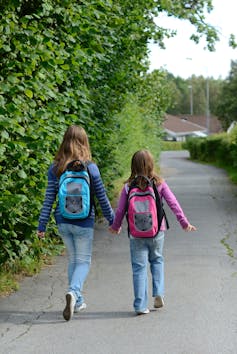If you grew up in the 1970s or before, you probably have fond memories of traipsing around the neighbourhood with your friends and siblings, going to the shops or the park, and walking to and from school – without a parent in sight.
Things couldn’t be more different for children today. With our increasing urbanisation, dependence on cars, and parental concerns about traffic or strangers, busy parents run an elaborate schedule of pick-ups and drop-offs to schools, sports and social events.
Children’s lack of independent mobility is not only a concern for their levels of physical activity, it also impacts on their broader personal, spatial and social skills. The benefits of children’s everyday mobility range from learning to navigate local streets, to interacting with people in public, to gaining a sense of citizenship.
New research we conducted with colleagues at the University of Melbourne and with international collaborators as part of the Jack Brockhoff Child Health and Wellbeing Program suggests we ought to have more faith in children’s ability to travel independently and, as parents, help them make this transition in late primary school.
Melbourne snapshot
Our study, Stepping Out, was funded by VicHealth to explore children’s perspectives in the local government area of Moreland in Victoria, during 2011 and 2012.
By walking and talking with children across three schools as they negotiated daily travel journeys – as well as speaking with class groups, parents and teachers – we examined the factors that enable children’s mobility. The 48 children in the study were aged 10 to 12 and had a relatively high degree of freedom to travel to school, parks or shops unaccompanied by parents.
The late stages of primary school are a critical period for developing children’s confidence and independence to travel without their parents. This period helps prepare children for the transition to secondary school, and the common need to travel further from home using varied modes of transport such as buses and trains.
Children are initially nervous about travelling unaccompanied by a parent but quickly come to enjoy the feeling of freedom and actively seek greater opportunities for mobility.
In the study, children’s mobile skills and confidence were developed through gradual progression. Early on, parents walked with children to local destinations and practised new routes together. They then allowed them to walk or ride ahead, to travel part of the way by themselves, before eventually letting them walk all the way alone.

Parents also provided children with a mobile phone to carry and encouraged children to favour routes where there were plenty of other people around, and to travel with siblings or neighbourhood friends.
Ultimately, we found that mobile children were supported through a kind of mobile scaffolding in which they were resourced through various kinds of companions: travel companions such as friends, companion devices such as phones, and ambient companions such as people along busier routes.
Scaffolding children with a range of interdependent resources to support their mobility helps to challenge an implied dichotomy faced by parents between child dependence and independence.
Putting it into practice
Parents must always make individual judgements about their child’s capacity for increased independence in travel, as well as navigate options available in their local environment. Different geographical locations can have a large influence on options for child travel, and the participants in our study enjoyed the benefits – as well as risks – associated with living in an inner urban area.
Nevertheless, by providing children with opportunities to experience and practice mobility wherever possible, children are able to develop their skills and confidence to become an active participant in their local community before venturing out into the wider world.
Schools and local governments are assisting in developing children’s mobility by addressing infrastructure, safety measures, or formal active travel programs. Yet clearly there remain further opportunities for families and communities to build the interdependent scaffolding that supports children’s mobility through more local and informal organisation.

